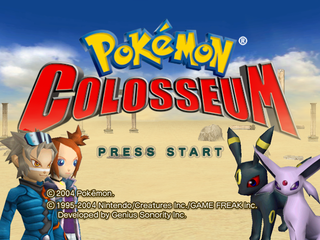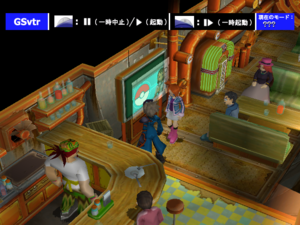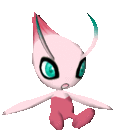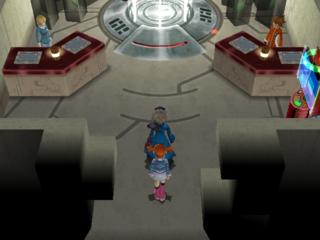Pokémon Colosseum
| Pokémon Colosseum |
|---|
|
Developer: Genius Sonority
|
Pokémon Colosseum is a weird combination of Dragon Quest and Pokémon. GOTTA SAVE 'EM ALL, MAN!
| To do: Fix this article. Also, there's supposedly a ton of unused text, unused animations [1], unused early Wes model possibly (?) talked about in a Japanese interview, plus Japan-only e-Reader content, and much more. |
Contents
Sub-Pages
| Prerelease Info |
| Unused Text |
| Bonus Discs |
Debug Mode
| This needs some investigation. Discuss ideas and findings on the talk page. Specifically: This might be different in the European version. There also is a debug_menu.fsys file in the ISO, investigate this. |
There is a small debug function that can be activated with the following Action Replay codes:
| USA | Europe |
|---|---|
0W0T-3G3X-BEGU4 761R-MU87-Y5HP6 VV06-B5P3-PQQJK 43X6-ZGAX-7CNFZ NBDE-ZNJ7-MDHZ1 |
ZVG4-2Q1X-1TXE3 CXJH-RJR6-M51AT ZKFE-CMMY-9GKHG 9393-TB37-2N5AG XTAM-9FPW-JC1VC |
]]
With the code activated, pressing D-Pad Up will show or hide a bar that has Japanese instructions on how to use the debug function. Pressing the L button will cycle between pause (instant stop), slow (low frame rate), and play (regular speed). Pressing R will pause the game, like when pressing L sometimes, but is more accessible and doesn't need to be cycled to.
Unused Graphics
face412 is a desaturated placeholder version of Bulbasaur's icon with no shiny. It's moved to the left by 1 pixel.
Pokémon Textures
All Pokémon models from the first and second generation are lifted directly from the Pokémon Stadium games. Interestingly, some include extra expressions that aren't present in the Nintendo 64 games, nor are used here either.
Meowth
A small "ooh" mouth.
Abra
Its eyes open.
Hypno
Its eye widened.
Kingler
An eye without a pupil.
Electrode
A narrow, smiling mouth.
Horsea
Its eye looking upward.
Goldeen
Its eye recoiling from an attack.
Gyarados
Its eye recoiling from an attack, included with its shiny variant as well.
Zapdos
Its eye recoiling from an attack.
Granbull
Its eye recoiling from an attack.
Magby
A starry eye.
Unused Text
Extra Shadow Pokémon
| To do: Add the rest of the story text referencing unused Shadow Pokémon. |
A list of Shadow Pokémon included in leftover debug text strings includes some that cannot be obtained in the final game: Spoink, Psyduck, Baltoy, Mightyena, Castform, Porygon2, Breloom, Lunatone, Solrock, Roselia, Chimecho, Minun, Electrode, Snorunt, Teddiursa, Corphish, Spheal, Sandslash, Magcargo, Kecleon, Whiscash, Xatu, Wobbuffet, and Wailmer.
Interestingly, one of the game's early Japanese commercials showed the main character with a Castform on his team, which could be related to when it was originally slated as a Shadow Pokemon. Additionally, Baltoy, Lunatone, Solrock, Roselia, Snorunt, Teddiursa, Spheal, and Magcargo were later introduced as Shadow Pokémon in the sequel, while Mightyena, Breloom, Electrode and Xatu can be obtained by evolving Shadow Pokémon in that game. Sandslash is also obtainable as Sandshrew can be captured in Poké Spots. While Psyduck isn’t a Shadow Pokémon, it’s evolution Golduck is.
Some of these Pokémon are also referenced by unused story text:
- I obtained the hard-to-find SHADOW KECLEON! It's a trivial thing. Only the person who knows the password of this mail's title will battle. They're waiting just before Pyrite Colosseum!
- I obtained the hard-to-find SHADOW KECLEON! It's a trivial thing. Only the person who knows the password of this mail's title will battle. They're waiting at the entrance to the Shadow Pokemon Research Lab!
- I obtained the hard-to-find SHADOW KECLEON! It's a trivial thing. Only the person who knows the password of this mail's title will battle. They're waiting at the entrance to Team Snag'em's hideout!
- Hi, it's NETT. I analyzed the SHADOW POKéMON LIST again and discovered six more. The additions are SKIPLOOM, QUAGSIRE, SUNFLORA, FURRET, MAGCARGO, AND MINUN.. I'll send another update if I can find any more.
- Hi, it's NETT. I analyzed the SHADOW POKéMON LIST again and discovered six more. The additions are ARIADOS, LEDIAN, SHUCKLE, MISDREAVUS, SPOINK, and ABSOL. I'll send another update if I can find any more.
- Hi, it's NETT. I analyzed the SHADOW POKéMON LIST again and discovered six more. The additions are HITMONTOP, REMORAID, MANTINE, MEDITITE, BALTOY, and KECLEON. I'll send another update if I can find any more.
- Hi, it's NETT. I analyzed the SHADOW POKéMON LIST again and discovered six more. The additions are SWABLU, CASTFORM, SMEARGLE, GLIGAR, STANTLER, and MURKROW. I'll send another update if I can find any more.
- Hi, it's NETT. I analyzed the SHADOW POKéMON LIST again and discovered six more. The additions are PILOSWINE, FORRETRESS, GLIGAR, SNEASEL, PSYDUCK, and TEDDIURSA. I'll send another update if I can find any more.
- Hi, it's NETT. I analyzed the SHADOW POKéMON LIST again and discovered six more. The additions are HERACROSS, PORYGON2, WHISCASH, XATU, WOBBUFFET, and WAILMER. I'll send another update if I can find any more.
Cut Line
A dialogue string, meant to be said by the girl ("Eh!? Chimecho isn't a Grass Pokémon... It's a Psychic Pokémon."), might be related to the Shadow Grass Pokémon King.
Cut Trainers
| Please elaborate. Having more detail is always a good thing. |
- "HUNTER RETAY": Unused "Hunter" class trainer.
- "MALPES THE RIDDLE-LOVER"
- "SHADOW GRASS POKéMON KING"
- "Six Shadow Aipom Siblings": Would likely be an encounter with a team of... well... six shadow Aipoms, or six siblings that train shadow Aipoms. Another possibility is that they could have worn Aipom-themed outfits...
Unused Entities
Shiny Celebi
(Click to animate)
For the sake of consistency, every Pokémon in every Pokémon game is given a Shiny variant, and Celebi is no exception. However, because the only way to obtain it legitimately was through distributions, the Shiny version of Celebi was left unobtainable through normal means.
Berry Juice
The only source of Berry Juice in any of the Generation III games would've been as a held item on wild Shuckle in FireRed and LeafGreen, but the event needed to make Shuckle appear in the wild was never released, so the item is effectively unused.
BERRY JUICE
A 100% pure juice that restores HP by 20 points.
e-Reader Leftovers
Card e Room
To do:
|
After completing the main story in the Japanese version, players could access the "Card e room" via the left door in the Phenac Stadium lobby, where they could battle VR Trainers by scanning Battle e cards. In international versions, both doors in the lobby lead to the battle area, though the Card e room is still seen in the demo that plays after waiting on the title screen. However, the Card e room is present yet inaccessible in international versions. There are translation mistakes like not capitalizing the first letter in the game's name. The word e-Reader uses a different letter "e" not seen elsewhere.
If you have gained access to the Card e room in the US version, you are able to use a Japanese e-Reader and e-Reader cards to battle VR Trainers. As the e-Reader itself is Japanese, all text on the e-Reader will be displayed in Japanese. You can not use an English e-Reader, and English e-Reader cards were never made available. Translation is nearly complete, with Japanese text still being displayed for the name of e-Reader cards that change the stadium, for the difficulties, and for the title card in the top left of the menu. In order to gain access to battles, you must load a program from the game onto the e-Reader. This program must be loaded from the US version, trying to use the program loaded from the Japanese version will not work.
In the European version, the game is unable to connect to the e-Reader. The Card e room's NPC dialogue is missing, and they will only display empty text boxes when interacted with.
To enter it, visit the basement of the Phenac City Pokémon Center with this Action Replay code.
| USA | Europe |
|---|---|
ED1R-7K1B-6MH0T 6V4G-BR63-1VBAG GMNK-UQNE-QR78H ZDXJ-VZFY-NTNQX NRTU-8KHF-1PZZ8 DEED-TK1H-U6N5P BHDF-N90M-BKMPV |
YY7R-UN4A-YYT8M 6V4G-BR63-1VBAG GMNK-UQNE-QR78H ZDXJ-VZFY-NTNQX NRTU-8KHF-1PZZ8 F57Q-1RNH-ZBAKF CNU4-TJFW-TR1W0 |
Although the e-Reader content was removed from the international versions, the theme used for the menu screens, "virtual", can still be found on the disc.
Miscellaneous
- "cerebi_dat" in ex_shrine.fsys (used for the Relic Stone) is included in the main game disc, even though it is only used in the Japan bonus disc.
- The e-Reader content is present on the North American disc, including an unreleased 21st card.
- As Phenac Stadium is the only area in Pokémon Colosseum considered "underwater", and since the only Shadow Pokémon fought in Phenac Stadium are in the e-Reader room, the Dive Ball's 3.5× catch rate multiplier is also unused in the international versions.
| To do: Try to force-load this content. |
Removed Map Leftovers
Removed Dungeon
| To do: What happens if the maps are loaded? |
Pokémon Colosseum's maps have internal names which use prefixes denoting their content - "M#_" for cities, "D#" for dungeons, "S#" for the Outskirt Stand and Snagem Hideout, "T1_" for Orre Colosseum, and "ex_" for the Bonus Disk content.
Of the game's dungeon maps, D1_ is used for the Shadow Pokémon Lab, D2_ is used for Mt. Battle, and D4_ is used Realgam Tower, skipping over D3_, suggesting a dungeon was cut at some point in development (note that Pyrite Cave and The Under Subway are considered part of Pyrite Town and The Under, so use the "M2_" and "M4_" prefixes.)
Similarly, going by map index numbers, Mt. Battle occupies maps 074 through 095, while Realgam Tower occupies 102 through 119, with 096 through 101 consisting of empty maps with the default "met a distant land" met location text. These would have presumably belonged to D3_, suggesting it consisted of five maps.
Pokémon XD: Gale of Darkness retains Colosseum's map naming conventions, and repurposes the "D3_" prefix for the S.S. Libra.
Regional Differences
To do:
|
| Japan | International |
|---|---|
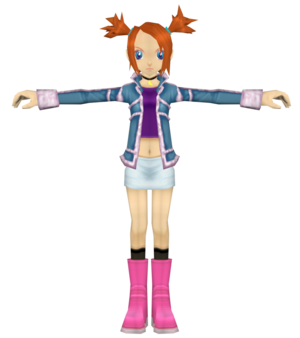 |

|
 |
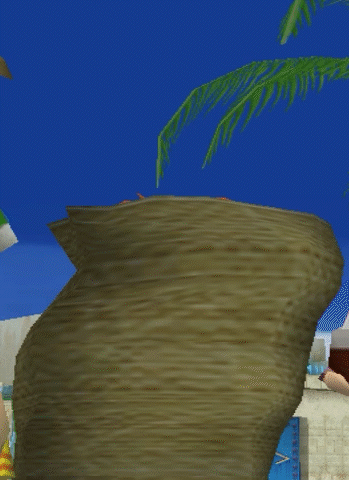
|
- The English logo was changed to remove the Japanese version's brick wall look. Oddly enough, an earlier version of the logo (with the brick background) was used for the boxart of the US Bonus Disc.
| Japan | International |
|---|---|
 |

|
 |

|
- The Japanese release of Pokémon Colosseum shows a slightly longer, more dramatic title-screen reveal in which the stone colosseum literally rises up out of the desert ground before the game logo appears. In the international release, that segment is shortened or in some cases appears skipped so that the colosseum is already on-screen by the time the title fades in.
| Japan | International |
|---|---|
- Additionally, Rui's model image on the Japanese title screen is of an older model, and her expression is different.
| Japan | International |
|---|---|
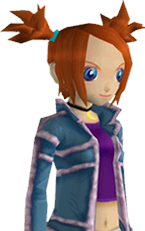 |

|
- In the Japanese version, Somek, the 100th trainer of Mt. Battle, wears a horseshoe moustache. In the international versions, he has no moustache.
| Japan | International |
|---|---|
 |

|
- This change is also reflected in his thumbnail image for each version, which can be found in chara_big.fsys inside chara_bigl074.gtx.
| Japan | International |
|---|---|
 |

|
- In the main menu, when selecting a mode, the Story Mode image featuring Wes and Umbreon was changed. The Japanese version's image uses an older Wes model, changed near the end of development.
| Japan | International |
|---|---|
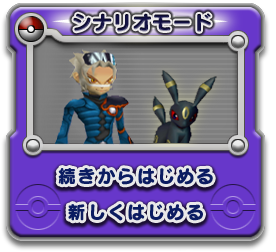 |
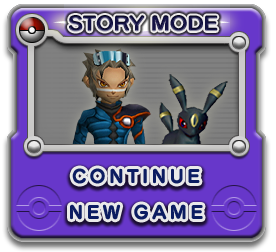
|
- Most of the differences in the credits come down to language, staff listings, and regional acknowledgments. The Japanese credits chiefly focus on Genius Sonority (the primary developer) and the Japanese publication staff including e-Reader related roles, since Colosseum had some e-Reader functionality there. Meanwhile, the U.S. credits add in all the localization teams, Nintendo of America staff, and any regional QA or marketing roles. There are also small differences in the final copyright lines. The Japanese version’s credits (often due to typographical or stylistic choices) displays “GAMEFREAK” as one word without spacing in between. Meanwhile, the international versions consistently list it as “GAME FREAK.” And lastly, the dates at the end reflect the different release years in each region so it shows “2003 Pokémon” and “1995–2003.” for the Japanese version and “2004 Pokémon” and “1995–2004.” for the international versions.
| Japan | International |
|---|---|
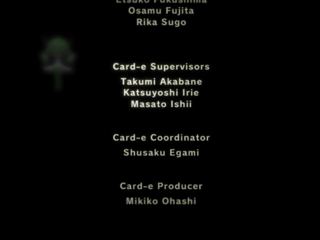 |
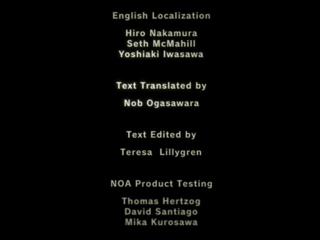
|
 |
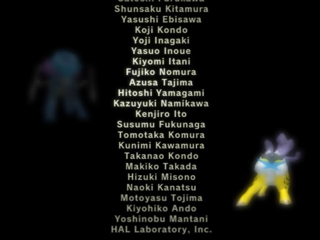
|
 |

|
- Additionally, the credits theme of the international versions has an extra 7 seconds added to the start, of a softer, more “atmospheric” or “relief‐like” lead‐in before the main musical phrase begins—whereas in the Japanese version, it jumps right into the main theme without that extra buildup. After that short intro in the international version, the rest of the piece matches up rhythmically and melodically with the Japanese track. It’s essentially the same composition, just with a slightly extended opening section for the international release. That extra intro probably helps align the music with the longer credit scroll in the Western versions (since they list additional localization staff). Everything else about the theme (its notes, instrumentation, and overall duration once it’s in full swing) is the same in both regions.
International Version
Japanese Version
- Three Shadow Pokémon are unobtainable by normal means due to the e-Reader room (see above) being dropped from the international versions. By completing a VR trainer difficulty, the player would be challenged by a real trainer in the e-Reader Room with a Shadow Pokémon. There's one trainer for completing each difficulty, and the Shadow Pokémon that were obtainable were Togepi, Mareep, and Scizor. Interestingly, Togepi and Mareep have evolved forms already in the regular game as Shadow Pokémon, and they would go on to be used as Shadow Pokémon again in Pokémon XD: Gale of Darkness.
- Pages missing developer references
- Games developed by Genius Sonority
- Pages missing publisher references
- Games published by The Pokémon Company
- Games published by Nintendo
- GameCube games
- Pages missing date references
- Games released in 2003
- Games released in November
- Games released on November 21
- Games with unused enemies
- Games with unused graphics
- Games with unused items
- Games with unused music
- Games with unused text
- Games with debugging functions
- Games with regional differences
- To do
- To investigate
- Articles requiring elaboration
- Pokémon series
- E-Reader compatible games
Cleanup > Articles requiring elaboration
Cleanup > Pages missing date references
Cleanup > Pages missing developer references
Cleanup > Pages missing publisher references
Cleanup > To do
Cleanup > To investigate
Games > Games by content > Games with debugging functions
Games > Games by content > Games with regional differences
Games > Games by content > Games with unused enemies
Games > Games by content > Games with unused graphics
Games > Games by content > Games with unused items
Games > Games by content > Games with unused music
Games > Games by content > Games with unused text
Games > Games by developer > Games developed by Genius Sonority
Games > Games by platform > GameCube games
Games > Games by platform > GameCube games
Games > Games by platform > Game Boy Advance games > E-Reader compatible games
Games > Games by publisher > Games published by Creatures
Games > Games by publisher > Games published by Game Freak
Games > Games by publisher > Games published by Nintendo
Games > Games by publisher > Games published by Nintendo > Games published by The Pokémon Company
Games > Games by release date > Games released in 2003
Games > Games by release date > Games released in November
Games > Games by release date > Games released in November > Games released on November 21
Games > Games by series > Pokémon series
